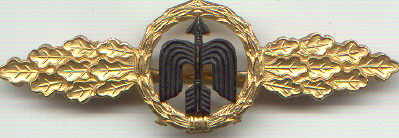| |
|
|
| |
|
|
|
|
| |
Home |
|
| |
|
|
|
|
| |
Back |
|
| |
|
|
|
|
| |
Why were the GefStds of JK, JD, Jafü and NJRF not systematically
attacked? |
|
| |
|
|
| |
|
|
| |
Why did allied airpower not systematically attack especially the JD GefStd bunkers. After SEP 1943 these airdefence centers were pivotal in the conduct of especially night air defence. I can only recall 5
historic examples of air attacks. |
|
| |
|
|
| |
The GefStd II JK was bombed by P-47 on 14 June 1944, no results. |
|
| |
|
|
| |
5 JD was
bombed on 24 August 1944, suffered no hits, but a nearby castle was burnt to the ground. This castle could actually have been the GefStd, since it seems as if the
bunker never became operational. |
|
| |
|
|
| |
The airfield of Schleissheim was bombed in the autumn of 1944, the GefStd of 7 JD was untouched, but the telephone lines suffered such severe damage so the bunker for that reason was abandoned.
|
|
| |
|
|
| |
When Oboe was to be field tested in DEC 1942, the intended target was the GefStd of NJRF 7 at Florennes, but for some reasons it was abandoned. |
|
| |
|
|
| |
Jafü Süd.Frank., Avignon was attacked 14 AUG 1944 in preparation of Operation
Anvil/Dragoon. The facility was rendered inoperative and abandoned. |
|
| |
|
|
| |
Sometime between 6 June and 17 September 1944 an Oboe attack was attempted on the GefStd
of 3 JD. KOMET, which was the Auswertung for the Naxburg net, tried to warn the controller in Deelen. The controller had never heard about KOMET and the capabilities of Naxburg, hence he was somewhat dubious about the fidelity of
information, which gave an actual countdown to bomb release. Bombs were dropped, but the result of the attack is unknown. |
|
| |
|
|
| |
In my opinion it is one of the more grievous operational mistakes on part of the allied leadership, that these facilities were not systematically destroyed, especially after the spring of 1944 when the GefStd of the JD had assumed such an
important, central role in exercising operational, tactical and intercept control.
Hundreds of aircrews and aircraft could have been saved, and the strategic bombing offensive could have proceeded much more effectively. If I recall correctly the RAF lost about
1.000 bombers during the battle of Berlin in the winter of 1943 - spring 1944.
According to Professor R.V. Jones it was certainly not due to lack of intelligence and I have POW interrogation reports from PRO, which clearly describes tactics, techniques, procedures and location for the GefStd of 1 JD . Still they were not
prioritized. Below is a copy of a memo, submitted by A.I.3 JAN
1944; discussing attacks on these targets.
Some would argue that no suitable weapons were available. Both the Tall-Boy and the Grand Slam could have cracked even the Baustarke A bunkers, and even if no direct hits were obtained the area around the bunker would have been turned into an impassable
moonscape. And certainly the telephone lines would have suffered. Some would argue correctly that it was hard to hit a pinpoint target at night, but with low level ground marking, I would counter argue that it certainly would be possible.
|
|
| |
|
|
| |
A.I.3 report. |
|
| |
|
|
| |
The Luftwaffe certainly expected air attacks against these facilities. They were very well hardened. In Gedhus even the telephone cable tunnel leading into the bunker is in "A" - as the contractor found out recently, when he attempted to remove some
of it beneath a new parking lot. They were well camouflaged and had dedicated Flak sections for their defence.
|
|
| |
|
|
| |
I am almost sure/sure that the following were not attacked:
|
|
| |
OKL Wildpark. Underground, "A"/"B".
|
|
| |
Lft.Reich Berlin Wannsee. Above ground, "B". |
|
| |
1 JD, Döberitz. Above ground, "FA" !
|
|
| |
2 JD, Stade. Partly below surface level, "A". |
|
| |
3 JD, Deelen. "A". |
|
| |
4 JD, Metz. Above ground FA/Hybrid |
|
| |
Jafü Däne, Grove/Gedhus. "A".
|
|
| |
Jafü Norwegen, Stavanger-Forus. Underground, "B".
|
|
| |
8 JD, Vienna. Castle. |
|
| |
|
|
| |
My historical data might be wrong in which case I would welcome corrections.
|
|
| |
|
|
|
|
| |
|
|
|
|
| |
 |
|
| |
|
|
|
|
| |
Back |
|
| |
|
|
|
|
| |
Home |
|
| |
|
|
|
|
![]()